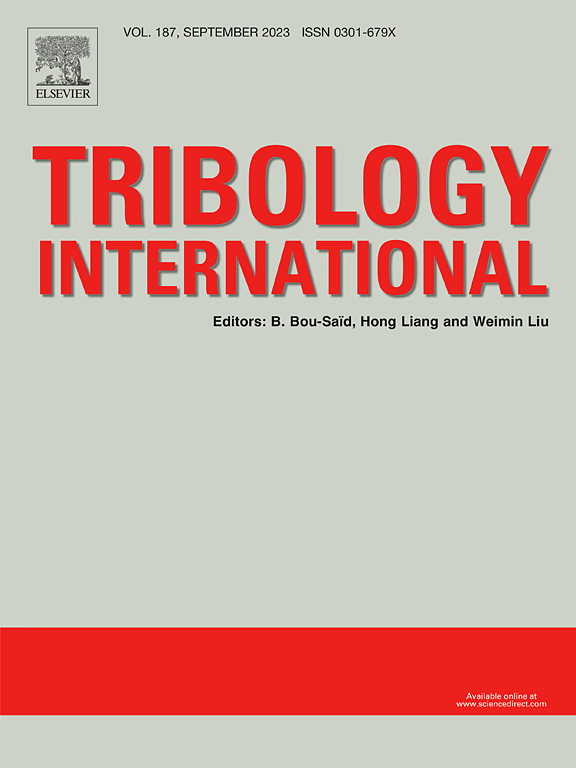Fretting behavior of hydrogenated nitrile rubber for sealing application of ultra-deep well
IF 6.1
1区 工程技术
Q1 ENGINEERING, MECHANICAL
引用次数: 0
Abstract
With complex operating conditions and frequent pressure fluctuations in ultra-deep wells, the fretting wear caused by tubing string vibration inevitably affects the sealing performance of packer cartridge during well completion. In response to reveal the fretting damaged mechanism of cartridge rubber, an experimental and simulated investigation was carried out. Reciprocating fretting tests of hydrogenated nitrile rubber (HNBR) against casing steel (N-80) were conducted at 25 ℃, 65 ℃, 105 ℃, 145 ℃, and the displacement amplitude ranges from 0.25– 4 mm. The results indicate that the fretting state transfers from mixed fretting region (MFR) to partial slip region (PSR)/MFR with the increased temperature under lower displacement amplitude (0.25–1 mm), where the wear rate shows a decline with the increased temperature. It is mainly because that the increased sticky characteristics with temperature can decline the relative sliding. Under larger displacement amplitude (2–4 mm), the running condition transferred from slip region (SR) to MFR with the increased temperature eventually, where the interface is mainly dominated by sliding. The wear rate shows a dramatically increase with the increase in temperature due to the sharply decline of mechanical properties. The interfacial displacement variation obtained by finite element calculation are verified with the running condition of fretting map (RCFM). The established materials response fretting map for HNBR can gave an epoch-making reference on how to identifying the risk of sealing failure duo to tubing string vibration for a packer. This research also can highly enrich the fretting tribological theory in terms of high temperature.
Statement of originality
I write on behalf of myself and all co-authors to confirm that the results reported in the manuscript are original and neither the entire work, nor any of its parts have been previously published. The authors confirm that the article has not been submitted to peer review, nor has been accepted for publishing in another journal. The authors confirm that the research in their work is original, and that all the data given in the article are real and authentic. If necessary, the article can be recalled, and errors corrected.
超深井密封应用中氢化丁腈橡胶的摩擦行为
超深井作业条件复杂,压力波动频繁,在完井过程中,油管串振动引起的摩擦磨损不可避免地会影响封隔器胶筒的密封性能。为了揭示封隔器橡胶的摩擦磨损机理,我们进行了实验和模拟研究。分别在 25 ℃、65 ℃、105 ℃ 和 145 ℃ 下进行了氢化丁腈橡胶(HNBR)与套管钢(N-80)的往复烧蚀试验,位移幅度为 0.25-4 mm。结果表明,在较低的位移幅度(0.25-1 毫米)下,随着温度的升高,烧蚀状态从混合烧蚀区(MFR)转移到部分滑移区(PSR)/MFR,磨损率随温度升高而下降。这主要是因为随温度升高而增加的粘性会使相对滑动下降。在较大的位移振幅(2-4 毫米)下,随着温度的升高,运行条件最终从滑动区(SR)转移到多摩擦区(MFR),此时界面主要以滑动为主。由于机械性能急剧下降,磨损率随温度升高而急剧增加。有限元计算得到的界面位移变化与运行条件下的摩擦图(RCFM)进行了验证。所建立的 HNBR 材料响应摩擦图可以为如何识别封隔器因管线振动而导致密封失效的风险提供划时代的参考。原创性声明我谨代表我本人和所有共同作者确认,手稿中报告的结果是原创性的,整个工作或其任何部分以前都未曾发表过。作者确认该文章未提交同行评审,也未被其他期刊接受发表。作者确认其作品中的研究为原创,文章中提供的所有数据均真实可信。如有必要,可对文章进行修改,并更正错误。
本文章由计算机程序翻译,如有差异,请以英文原文为准。
求助全文
约1分钟内获得全文
求助全文
来源期刊

Tribology International
工程技术-工程:机械
CiteScore
10.10
自引率
16.10%
发文量
627
审稿时长
35 days
期刊介绍:
Tribology is the science of rubbing surfaces and contributes to every facet of our everyday life, from live cell friction to engine lubrication and seismology. As such tribology is truly multidisciplinary and this extraordinary breadth of scientific interest is reflected in the scope of Tribology International.
Tribology International seeks to publish original research papers of the highest scientific quality to provide an archival resource for scientists from all backgrounds. Written contributions are invited reporting experimental and modelling studies both in established areas of tribology and emerging fields. Scientific topics include the physics or chemistry of tribo-surfaces, bio-tribology, surface engineering and materials, contact mechanics, nano-tribology, lubricants and hydrodynamic lubrication.
 求助内容:
求助内容: 应助结果提醒方式:
应助结果提醒方式:


